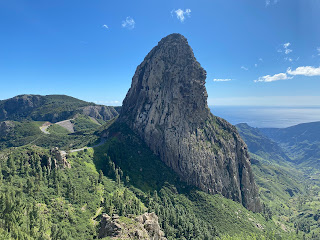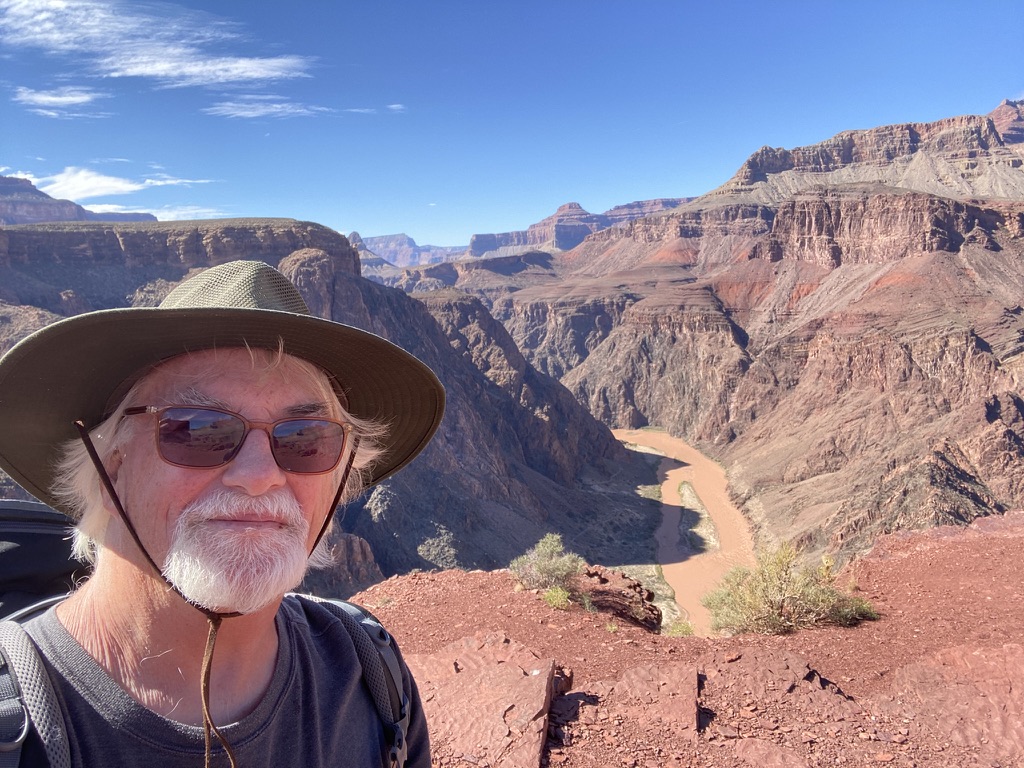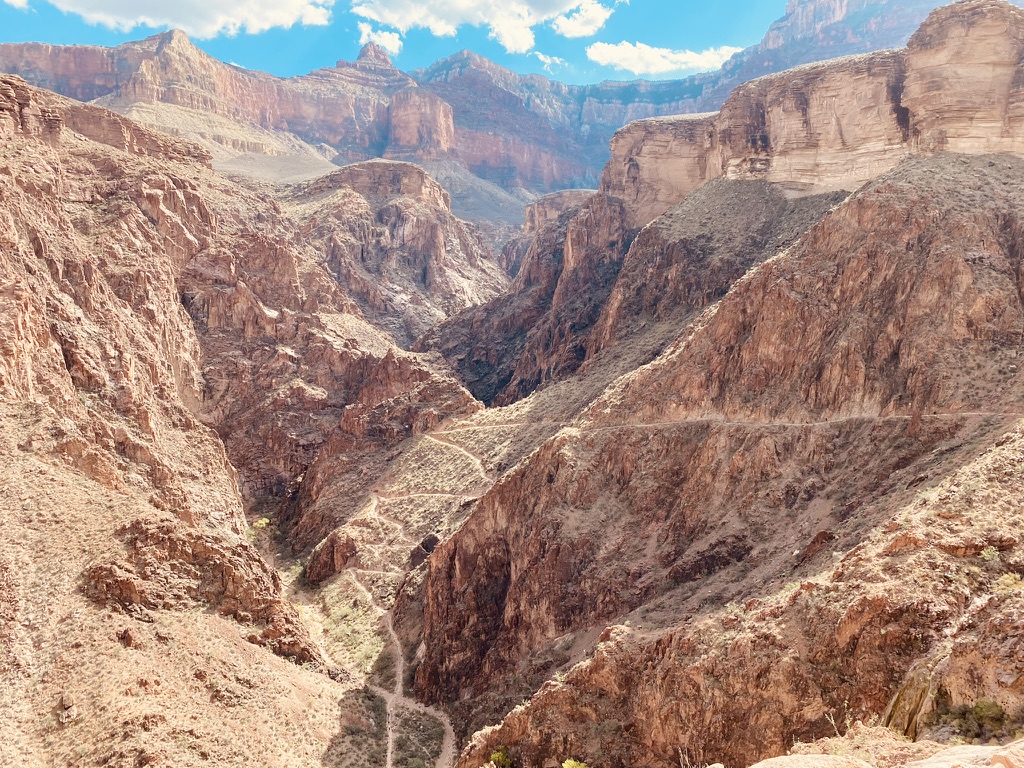If there is another place like Iceland on earth, I am unaware of it. The landscape is made from multiple layers of geothermal and geological disturbances that display a history of raucous events leaving dramatic evidence across the landscape over many millennia. There are jagged mountains that turn a vivid green in the summer. Steam rises from underground, geothermal water sources. Iceland is rumbling, bubbling, and rising. As climate change increases temperatures, the surface of the Earth rebounds upward as the weight of the melting ice decreases. Lava is everywhere. Ancient lava, covered with delicate moss, strewn over millions of square miles; more recent lava flows that look like rivers frozen in time, and red-hot molten lava spewing from active volcanos. Volcanoes are one of the main geographic features of Iceland. Iceland is the home to one-third of the lava that ever flowed on Earth. As much as 25% of the Icelandic land surface is covered with volcanoes. There are 32 volcanic systems comprising 130 different volcanic mountains. All this extraordinary scenery is surrounded by ocean and stark gray sand beaches.
On a lark, I took an opportunity presented by Play airlines (formerly WOW). I’d never heard of them, but they were offering cheap, round-trip fares from Stewart airport in Newburgh, New York (a short drive from where I live) to Reykjavík Iceland. I had always had Iceland in the back of my mind as a place to visit, hiker and nature nut that I am. And so, it came to pass. I boarded an outdated jet with amazingly uncomfortable seats. There are none of those little TV screens on the back of the seat in front of you, no free food, and very few accoutrements. The seats were narrow and crowded. If you wanted a roomer seat you could pay extra (anything from $25 for something just slightly better to $120 for an exit seat, or something in the roomier rows in the front. They charge you for pretty much everything. I had already pre-paid online for my luggage at a rate of $60 each way for 20 kg. I weighed in a 22 kg and right there at the check-in desk the took me for another $40 each way. They charge for carry-on baggage as well. I brought a few items on the plane in a fanny pack to avoid the carry-on fee.
If you get hungry of thirsty, you must press a button to summon one of the flight attendants, and order something which you will pay dearly for. Even if you just want water, you gotta open that wallet. Fortunately, the toilet paper in the bathroom is free.
The flight crew were all energetic, pleasant and of Icelandic dissent - possessing unbelievably long names.
The plane landed at about 4:30 in the morning. It was light like it would be at 10 in the morning this time of year where I live. Iceland in July gets dusk-like between the hours of 1 AM and 3 AM. I brought along some eyeshades to help me sleep.
There’s no way you can check into any hotel in the world at 5 AM in the morning. I booked my room for the night before so when I got to the hotel, I could immediately shower and nap.
The people from the airport shuttle bus company told me that my hotel was just across the street from the bus terminal in Reykjavík. It was not! In fact, I had to roll my 22 kg Northface expedition bag up and down hills for about 20 minutes until I reached the hotel. The light was so bright that I forgot what time it was. I kept saying to myself “my Reykjavík is such a quiet city.” It took me a while to realize that nobody was awake yet. I stayed at an “art hotel.” There were large, bold, beautiful paintings on display everywhere, and a spacious library with shelves that were lined with ancient volumes as well as modern murder mysteries. Long, leather couches formed squares around low coffee tables. Chess boards were plentiful. Since it was so early in the morning, I could catch a nap for an hour and still take advantage of the complimentary breakfast. After salmon, muesli, and yogurt I walked into the center of town. The hotel was just a couple blocks from a beautiful park with a lake named TjÖrnin SuÖurtjorn. I walked along until I reached the end, taking a left by the Monument to the Unknown Bureaucrat, past the City Hall bus stop where I would be picked up by the trekking company the next day at 7 AM.
I’ll just say it, Reykjavík is boujee! The downtown is chock-full of cobblestone streets lined with high-end shops selling hats, scarves, sweaters made by local weavers, and pricey, name-brand, outdoor apparel. Copious coffee houses, restaurants were all eagerly seeking top tourist kroner.
The wind was brisk off the bay, although, to my great surprise, the temperature rose to about 60ºf, and it was unabashedly sunny. I had studied the weather report carefully during the previous couple weeks and it looked dismal with clouds and drizzle. The average daily high was somewhere in the mid 50s and the low was somewhere in the mid 40s. I expected never to see the sun on this trip and yet on the first day I had to buy some cheap sunglasses from a drugstore. Oh, happy tragedy.
The seashore is rugged and beautiful. There’s a rocky gray beach where people have constructed thousands of clever looking cairns with volcanic rocks. The mountains across the bay are usually covered with snow in the promotional photographs but apparently not in July.
I walked 4 1/2 miles in and around the city center before I went back to the hotel for another nap (the first one didn’t really do it). I woke up hungry and began to forage for food. The people who worked in the restaurants and stores and we’re all friendly, polite, and fluent English speakers. I walked up the hill to a towering 244-foot steeple of a church. It’s really a steeple that goes all the way to the ground. Hallgrimskirkja celebrates the High Lutheran sect. The design is stark and spare like the Icelandic landscape. The church is named after the 17th-century clergyman Hallgrímur Pétursson. At the entrance to the church stands an imposing statue of Leif Erikson, whose father, Erik the Red, had much to do with the early settlement of Iceland.
Just about every name in Iceland is long and intriguing. It’s mystifying to hear the locals pronounce them. Even visitors from other Scandinavian countries have difficulty decoding. The Icelandic tongue (íslenska) has so many idiosyncrasies and difficult pronunciations that really no one else, besides the natives can speak it with any credibility. It’s likely that Icelanders speak excellent English because there’s no place in the world, they’re ever going to go where people will understand Icelandic and they’ve come to accept that.
On my second day in Iceland, I woke early and rolled my 40-pound Northface expedition bag down the hill and past the lake to City Hall where I was whisked away by an Arctic Adventures bus. There were two kinds of people on the bus. There was a day group that would drive four tedious hours out to Landmannalaugar, take a little hike, and hang around the busy campground for about four hours, and then get back on the bus for another four hours of tedious, driving back to Reykjavik. I was in the second group. We would spend two nights in a “hut” where we would sleep in rows, en masse dormitory style. The French call this a dortoir. I call it a snoretoir because somebody always starts snoring and hell, half the time it’s me. To save the others in the group (there were about 10 of us) I found a private bunk room that was meant for guides, but not being used on that particular night.
I got a pretty good night’s sleep, even though it never really gets dark in early July. It might get a little dusky at about 2 AM, but that’s it. I went out to relieve a call of nature around midnight, and the Hot Springs about 100 yards away, was packed with people soaking and socializing in animated voices.
We would spend three days hiking. The first day was beautiful, in terms of the scenery and the weather. It was unabashedly sunny! We went up and down several significant mountains, and finally arrived at a crater formed by a volcano at some point in the distant past. It was filled with water like a lake with deep purple colors around the edges. The hike was all downhill on the way back but added up to be about 13 or 14 km long. Everybody was “good tired” and just a little bit sore.
The next two days featured more challenging hikes. The brochure for this trip said the hikes would be easy to moderate. In our group, there were people of a variety of ages and trekking abilities. The second day hike went up and down several, steep, slippery hills. With the additional thrill of a traverse through a snow field. If one were to slip in the wrong place, one could easily fall to one’s death. A 50-year-old woman in our group got to the snow field and freaked out. She froze and couldn’t move. She wanted to call for a helicopter. Thankfully, her family coaxed her gently and she made her way slowly, gingerly through the snow field. This was not a moderate or easy hike. This was strenuous and difficult. An experienced guide probably wouldn’t take a group like ours on a hike like that. On the third day I stayed at the hut because I was nursing a case of plantar fasciitis, and the woman who freaked out on the snow field stayed behind as well. That day I hiked it to a peaceful, beautiful area on my own. I went through a range of volcanic, rhyolite mountains that nature had painted in a variety of vivid colors, and then up a steep path to some places where steam would rise from mud springs or fumaroles. It was a novelty to play around in the steam; not something you run into much of any place else.
The group would share two meals a day together in the hut dining area. After breakfast in the morning our guides would make sandwiches for lunch. We hearty meals washed down with wine at night.
Our Slovenian guide was on her maiden voyage in terms of leading 3-day excursions. She was in her mid-20s, energetic, helpful, and pleasant. She seemed unsure of herself in certain ways which gave away the fact that this was her first rodeo. She made several trips to the Ranger station to make sure she had the right directions for the hike. She got a little bit lost on the first day. Everyone has to start somewhere. Maybe after she gets more experience, she’ll develop a keener sense of each group and what kind of hike they should take.
After we got back to Reykjavík, I rented a car and drove out Route 1 on the southern tier of what they call the “golden circle” that circumnavigates the entire island of Iceland. Many folks who visit Iceland spend a week to ten days driving the length the golden circle. I prefer to spend less time driving and more time walking.
On the subject tourists, it should be noted that Iceland, in general is inundated with them during the summer. People from the sizzling south of Europe in particular, like to get a break from the extreme heat that has plagued them in recent years. At Landmannalaugar there were throngs and throngs of people with backpacks and expensive hiking gear all looking to get a 3-4 hour walk through the beautiful Icelandic interior. There was a full campground next to the hut where we stayed. The hut had at least 40 or 50 other people staying in the other bunk rooms. The parking lot was full and folks just kept showing up. You can’t blame people for loving beauty I suppose.
On Route 1, in my rented jeep, there were many beautiful places to stop. Like national parks in the US, hundreds and hundreds of people would be parked in a pay lot in order to take in the beautiful sight of a glacier or waterfall. There were inevitably restaurants and hotels that would surround these points of interest. It cost between two and three dollars per squirt to the public bathrooms. It was easy to duck the fee and most people did.
I stayed in a country guesthouse with beautiful facilities. They were 20k from the nearest town and the only thing the hotel restaurant served for dinner was fish and chips. Out of inertia I opted fror the fish and chips, and hell, it was good.
I took a walk after dinner down to the sea and got at least 2/3 of the way there before it started raining. This was the first time. Before I got to Iceland, I thought that every day would be in the mid 50s and drizzling.
The next day, if you can believe it, was even warmer and sunnier than the ones before it. The bright sun brought out the rich verdant green of the moss that grew on the side of the mountains. The immense, brilliant, Myrduls-Jokull glacier capped the high plains. The air was hyper-clear and full of detail; you could see a bug on a rock 100 yards away.
I walked up a steep hillside to the edge of the glacier. The ice wasn’t pristine, white, or ethereal blue like you might see in an arctic climate. This ice dirty white with a translucent coat of black volcanic dust on it. The island has gone through thousands and thousands of major and minor volcanic incidents over the centuries. History has left a stain on the teeth of each glacier.
After the Glacier hike, I drove south on Route 1 to the town of Vik. Vik had been the location of a Netflix series I had recently watched called Katla after the kind of wool they make Icelandic sweaters out of. The setting was beautiful, bleak, and quintessentially Icelandic. An icon of the series was three stone spires rising from the sea. In the American west, they would call them hoodoos. I had to go to Vik if we’re no other reason than two photograph, the spires that are burned in my mind after watching this very disturbing and dark series.
My final destination of the trip, the Blue Lagoon, was not actually far from the airport. The entire drive, westward from Vik, was highlighted by gorgeous green jagged mountains to my right in the endless ocean to my left. After about 3 1/2 hours of driving, I arrived at the Blue Lagoon. It’s a resort that features unique Hot Springs with water that is a milky blue shade is due to its high silica content. The silica forms soft white mud on the bottom of the lake which bathers rub on themselves. The extraordinary amount of salt in the water, makes it very easy to float in. It contained all kinds of other beneficial minerals and left me with a glow that lasted well into the night. I got a series of 3 silica mud face masks from a little stand that you can swim up to. The first mask consists of black mud that you spread on your face and quickly wash it off after three minutes. The second mask is a white paste that supposed to do something cool to your skin. You wear that for about 10 minutes and wash it off. The third mask looks like green pistachio ice cream, looking substance that is intended to rejuvenate your face. My 68 year-old mug course could use all the rejuvenation it can get.
The Blue Lagoon is adjacent to the Svartsengi Power Station a geothermal power plant, which is in the Svartsengi geothermal field. The world´s first geothermal power plant for electric power generation and hot water production for district heating. The electric power station was built in 1976. The Blue Lagoon is actually fed by the water that has been processed through the plant.
All the rooms at the Blue Lagoon resort were booked so I stayed at the North Light on the other side of the power station. When I first saw the hotel next to the steam plant, I thought for sure the place would stink of sulfur. It did not. Not far from the hotel, about 30 km, was an actively erupting volcano. I found this disconcerting. Local people scoffed at the possibility of a major volcanic eruption, in fact, droves of tourists were driving oof-road vehicles into the hills near the volcano, to get a front row seat on the action.





















